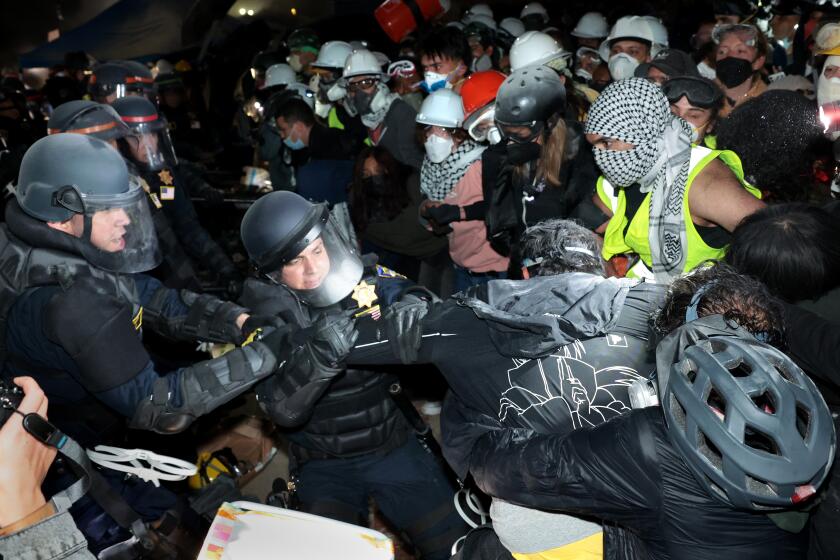Space Jam on Campus
Mission College’s quadrangle is smaller than the backyards of many San Fernando Valley houses.
Officials say the diminutive campus, although clean and modern, lacks enough classrooms to meet the academic needs of one of the Valley’s poorest areas--where 40% of residents are high school dropouts, according to U.S. Census data.
Yet the 22-acre campus has the fastest-growing enrollment in the Los Angeles Community College District. Enrollment increased 15%--to 7,000 students--this fall, and officials expect that total to double in five years.
“Right now, we’re at 95% capacity,” said Thomas Oliver, Mission College’s interim president.
With the space shortage looming as the biggest issue confronting the college, three expansion proposals have surfaced recently from campus and political leaders, but all lack details on timing and financing. At the same time, the college is pressing ahead with a presidential search that was thwarted last spring by political turmoil.
To cope with overcrowding, Mission College is leasing nearby high school classrooms and offering an array of online courses to ease its growing pains. It has forgone athletics, performing arts and many other trappings of the college experience. Mission College also spends less per student, has a lower percentage of full-time teachers and fewer upper-level courses than any other college in the district.
As a result, Mission College students are more likely than others in the district to finish their transfer prerequisites or associate degrees at other community colleges, despite the fact that Mission has the district’s newest, most technologically advanced campus.
“We are turning students away,” Oliver said. “We lose students because we’re not offering all of the complementary classes.”
Most of Mission’s normally packed classrooms are designed for 25 students, whereas the state average is about 35 students per classroom.
Shari Borchetta, vice president of administrative services, has worked at Mission College since it opened in 1975. She said the college’s predicament is taking a toll on students’ morale.
“These young people want a sense that they are on a real campus,” she said. “They want to feel like they’re part of an academic community like Valley, Pierce or CSUN could give them.”
Former president William E. Norlund retired last spring after failing to expand the campus, and the college is having a hard time finding qualified candidates to replace him. After a messy, politically charged candidate search last spring, trustees rejected all three finalists and started anew.
Growth Has Been Strong From Start
Mission College’s future seemed brighter in 1974 when its first president, Herbert Ravetch, conducted a district feasibility study to assess the need for a third community college in the Valley. The study found that twice as many residents in the predominantly white West and central Valley areas attended the community colleges as in the ethnically diverse northeast Valley.
Initially, the district hoped to build a campus on an 80-acre parcel in Northridge. But Ravetch determined “there was definitely a need for another college, but that was the wrong place.”
So the next year the district leased two dozen classrooms that were scattered across the northeast Valley, some in storefronts, some in churches, some next to bars and near strip joints. Teachers still tell stories of loud music blaring through walls and drunks wandering into classrooms. Mission’s growth was dramatic from the start--1,400 students enrolled the first year and 3,000 the second.
Eventually, the district bought Mission College’s present site from the Los Angeles Unified School District, a contentious deal that ended with the ouster of Mission’s second president.
The site is as small now as it was then, but officials had presumed future expansion would be easy because the land abuts the county-owned El Cariso Regional Park and Golf Course.
“After all,” said Carlos Nava, vice president of student services, “we thought education has a much higher priority than a park or golf course . . . but that’s turning out to be other than true.”
As recently as last year, Mission College’s advances into county territory were rebuffed by irate equestrians, hang-gliders, golfers and youth baseball fans who use the facilities and who complained to the Board of Supervisors.
Assemblyman Tony Cardenas (D-Sylmar) still holds out hope the county can be persuaded to part with some of its parkland. “In my opinion, we can find a way to accommodate golfers and expand,” he said.
Cardenas said the golf course and park boundaries can be pushed eastward into the Pacoima Wash, as long the U.S. Army Corps of Engineers, owner of the wash, cooperates.
Cardenas’ plan has been derided by many, including Norlund, the former Mission president, who said the area’s political leadership lacks the clout and finesse to win over the Board of Supervisors.
“They [Cardenas and Democratic state Sen. Richard Alarcon of Sylmar] have to deal with the county on this and they don’t seem to be on speaking terms with the county,” Norlund said. “I don’t think they have the political sophistication.”
County Supervisor Zev Yaroslavsky said last week he opposes ceding any parkland to the college.
“This is not a county problem,” he said. “This is primarily a junior college and a district problem.”
Yaroslavsky said he has an expansion proposal that “means using existing land and not dreaming about acquiring new land.”
He said he envisions a parking structure for park users and students--financed by the district and the county--that would free most of Mission College’s 5-acre parking spaces for new buildings. Yaroslavsky said he had not outlined his proposal to the district.
“As small as it is, [Mission] has a lot of open space,” he said.
Campus to Get New Building
Oliver, the interim president, has resigned himself to developing the existing campus. Construction will begin next year on a new laboratory and classroom building with $4.7 million originally slated for land acquisition.
Oliver also hopes to find funding for four additional projects on the existing campus: a student services building, an expansion of the culinary arts program, a library learning resource center and a child-care center. The projects would cost an estimated $26 million and increase Mission College’s capacity to about 9,000 students, he said.
But his plan has generated little support. “It will look like Manhattan,” said one educator. And district insiders doubt Oliver will be at the helm long enough to fulfill his vision.
Cardenas and others also complain that the at-large district board of trustees has marginalized the northeast Valley. Until Georgia Mercer of Tarzana was elected in the spring, no Valley resident had ever sat on the seven-member board.
Earlier this month, Gov. Gray Davis vetoed a bill sponsored by Cardenas that would have replaced at-large district elections with seven specific trustee areas. Supporters of the bill argued it would have created a more representative board.
The current board supported Cardenas’ bill. Kelly Candaele, who chairs the community college board, and district Chancellor Mark Drummond have pledged to create more equity among the district’s nine colleges by changing the formula by which campuses are allotted funds.
Lupe Ramirez, the 84-year-old community activist many credit for bringing Mission College to Sylmar in 1975, says the college’s potential has been long undermined by unresponsive leadership on the district board and in Sacramento.
“It was racism then, and it still is racism,” she said.
Ramirez, who recently moved from San Fernando to Oceanside in San Diego County, said she recognizes the strides made by Mission College but said the school “is not all that I hoped for.”
*
Times staff writer T. Christian Miller contributed to this story.
More to Read
Sign up for Essential California
The most important California stories and recommendations in your inbox every morning.
You may occasionally receive promotional content from the Los Angeles Times.






